Player development is one of the key areas in football. It is a long-term investment which can bring youth players from the academies to the first team, already in possession of the necessary attributes that fit the club’s philosophy. The club can later profit from transfer fees and closes the circle as the process starts over again every year. Certain sides establish such a strong system that they can build the whole team around academy graduates, finding a balance between youth and experience.
In this data analysis, we dive into the world of FC Nordsjaelland and analyse one of their bright prospect, Magnus Kofod Andersen. The article aims to create a general data-based player profile on him. While we give an estimate on how Andersen’s career could progress, it is a purely analytical approach and might not be accurate. It will feature numerous player comparisons and new methods to determine the young star’s future potential and how he could reach it.
Background
When someone says Nordsjaelland, a well-informed football fan could refer to tricky set-piece variations or the club’s humanitarian partnership with the Right to Dream Academy in Ghana. Among these bits, Wild Tigers’ own academy is often forgotten but it plays an equal part in their success. After the foundation in 2003, the club aimed to develop their profile as a regional team. A network of more than 60 local football clubs from the surrounding area was created to recruit young talents in the region and give them playing time.
Andersen is one of the finest results of the continuous effort of FC Nordsjaelland to discover and develop youngsters. He joined at the age of 10 and practically has spent half of his life in the team. His first-team debut came in 2017 and by 2018, he became the captain and has been wearing the armband ever since. This should tell a lot about his mature character as there is something romantic about young captains in modern football (Steven Gerrard of Liverpool or Fernando Torres of Atletico Madrid are just a couple of examples).
Basic scout report
In this bite-size section, we will focus on his passing range, vision and decision-making. At first glance, one could have a feeling that he is like a quarterback in an NFL team. When he has enough time on the ball, he won’t hesitate to pick out the option which would be the most beneficial for the attacking development. This might seem obvious but many elite coaches prefer their midfielders to play the ball safe and risk-free to the closest option. In the case of Andersen, he will mainly focus on deep runs, shifts in the defensive line and will try to exploit it.
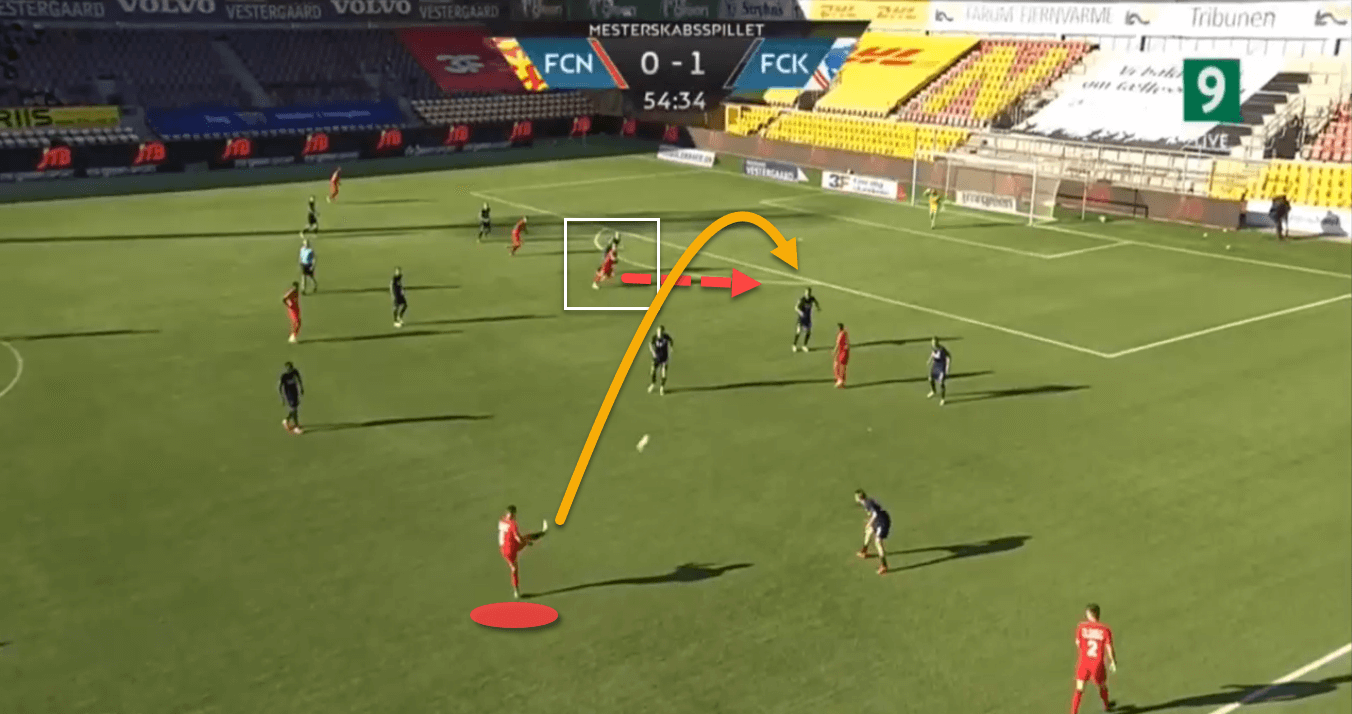
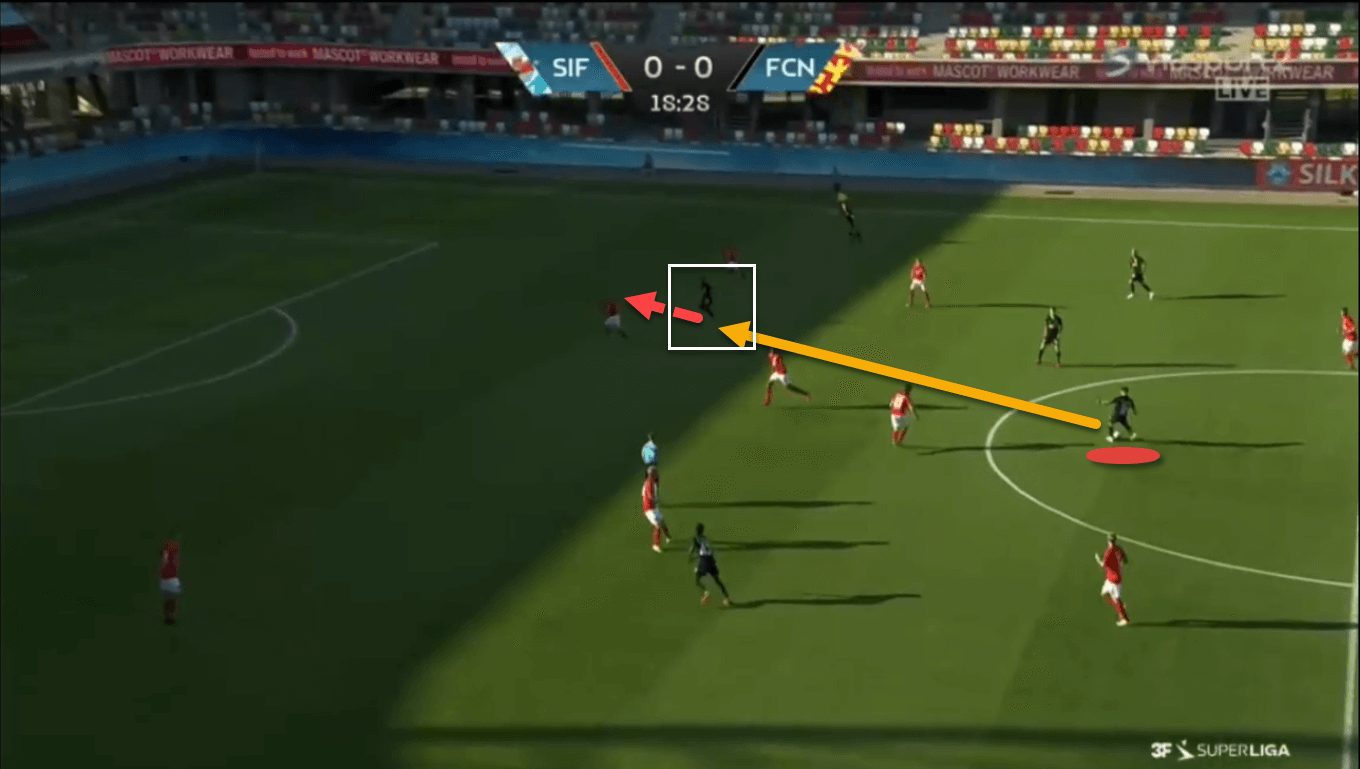
This results in fewer passes in general since he always tries to dictate the tempo with vertical balls and more inaccuracies as well. This is basically a high-risk, high-reward approach that Nordsjaelland also favour. His vision and passing technique make it easy for him to send through balls in any range while he is trusted to make the best decisions.
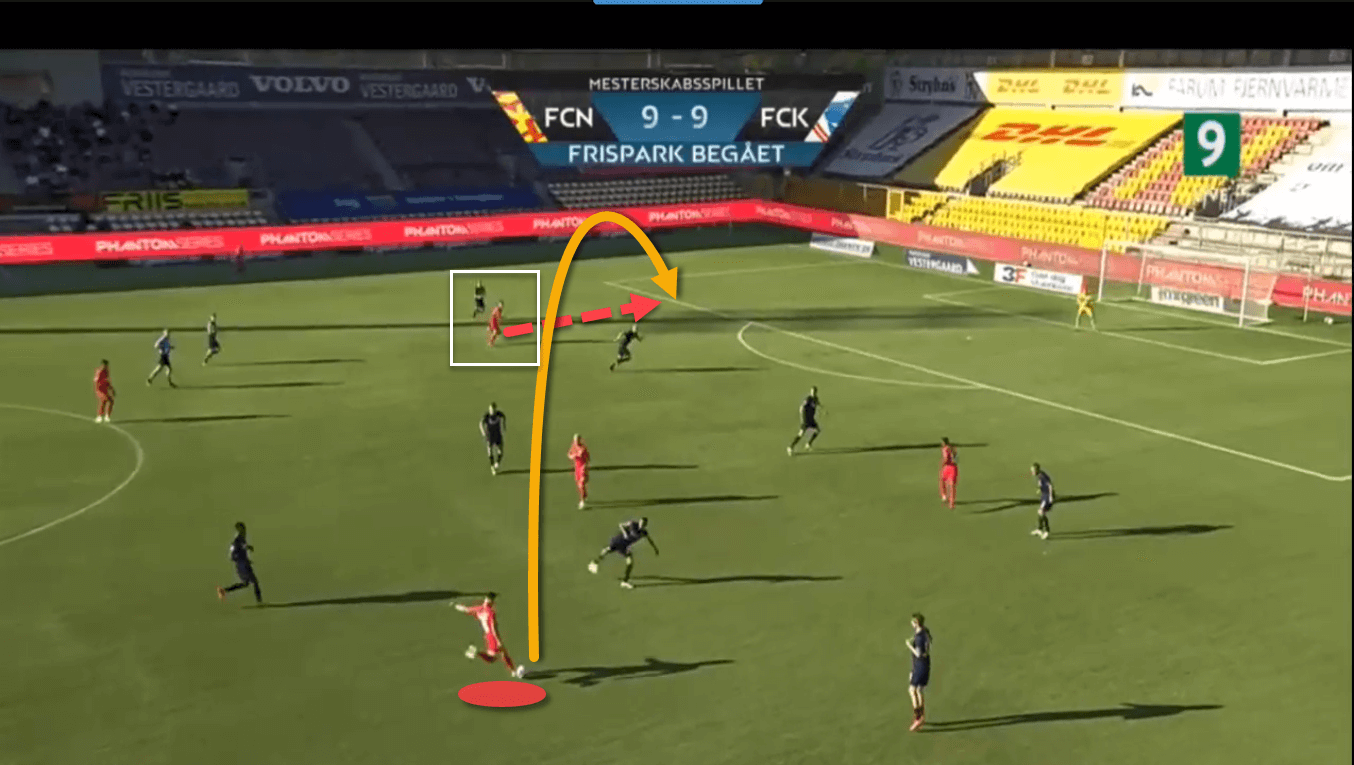
Profiling
Andersen is listed as a central midfielder with a defensive secondary role. We can try and profile him based on his last two seasons. Dividing the roles in the centre for three parts (ball-winning midfielder, deep-lying playmaker and attacking midfielder) can help us with the appropriate statistics. Taking all central midfielders from the top five leagues makes sure that we get a true grip on Andersen’s playing style. Ball-winning midfielders engage in numerous defensive duels over the game and traditionally intercept many through balls. Playmakers lead the team from the back, often dropping between the centre-backs, therefore we rarely see them in an advanced position. Progressive passes and runs per 90 could be good indicators of a more withdrawn player. Finally, advanced playmakers usually arrive in the box late and have the most chances to shoot compared to the previous two groups.

We can see Andersen’s role and statistics have slightly changed over the last two seasons. He became a more attacking-minded player as he is instructed to push a bit higher for the team. The ternary chart also shows that even though he is considered to be a defensive midfielder on paper, it is better to think of him as a hybrid playmaker. The chart proves our eye-test regarding his style.
A year in numbers
The first part of the analysis aimed to profile Andersen and we identified him as a deep-lying playmaker who progressed with his role compared to the previous season. Now, it is time to see how he fares in different groups. First, we continue to use the top five league central midfielders as references as we compare Andersen to the cream of Europe. With the help of percentile ranks, we can standardize the process and the charts can give us an idea of where the Danish youngster has to improve in his passing game.
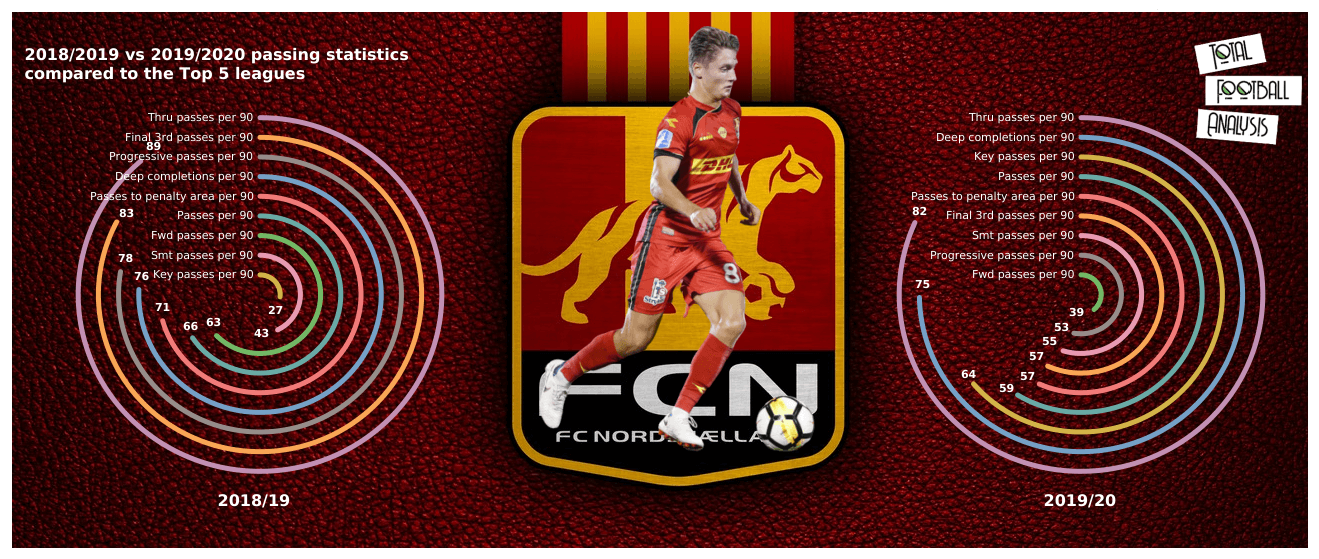
Already through the scout report, it became clear that Andersen is a gifted passer. Based on the charts, we can also come to this conclusion. Interestingly, his numbers of this season have deteriorated slightly. One possible explanation can be his somewhat more advanced positioning and less time on the ball. Either way, he still shows the above-average capability of creating chances and a balanced overall picture.
Within the age group
As the title suggests, we have to analyse Andersen’s performance among his peers as well. This means players under 21 from the Premier League, La Liga, Serie A, Bundesliga, Ligue 1 and other, traditionally strong youth-developing countries like Denmark, Belgium, Portugal and the Netherlands. The three main aspects followed the same logic stated in the previous sections. When assessing a midfielder’s performance, the ability to progress the ball either by passing or dribbling as well as basic defensive skills should be taken into account.
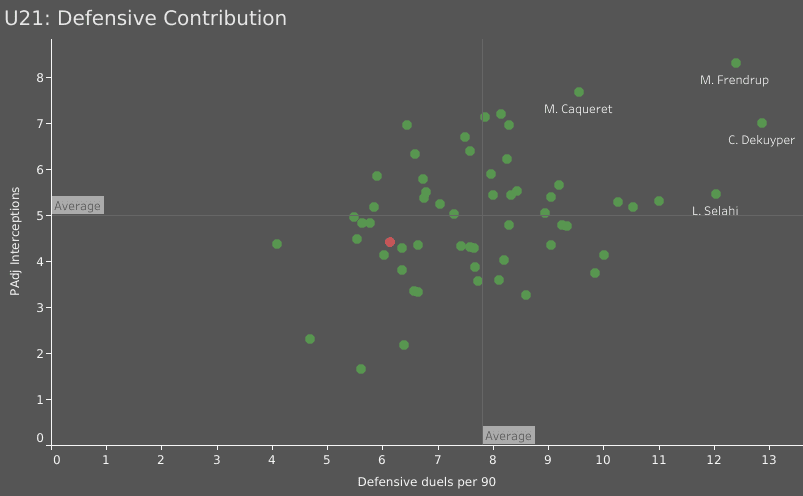
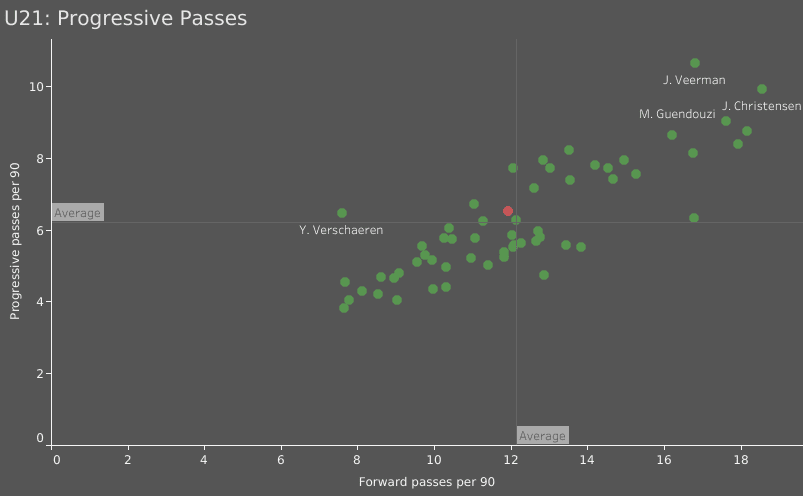
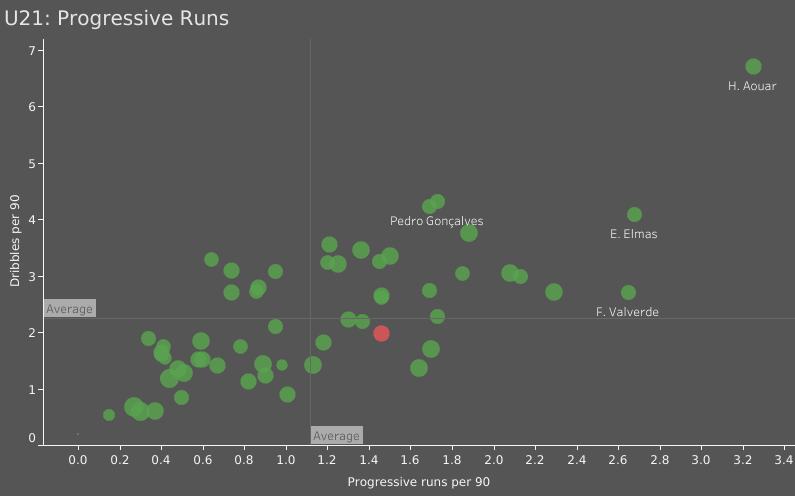
In all three cases, Andersen moves around the average showing room for improvement. Nordsjaelland’s approach in the passing game could still assist in his growth.
Passing profile and similar players
One of the toughest areas in recruiting and scouting is to estimate future potential. Every player is unique, their personalities and mental strength play just as important part in their careers as their on-field performance. In this data-based approach, we aim to find similar players in style. As we move on in the process, we can determine an approximate career path based on our findings and just hope that Andersen can fulfil his potential.
As a first step, we distributed the top five league central midfielders along an x and a y-axis. Even though the chart has the limitation of two dimensions, we took three metrics into the calculation, forward, lateral and back passes, the definitive tools in football. Therefore, the player’s position on the graph holds crucial information. Two midfielders close to each other have matching passing profiles, meaning we can start our comparisons with them.
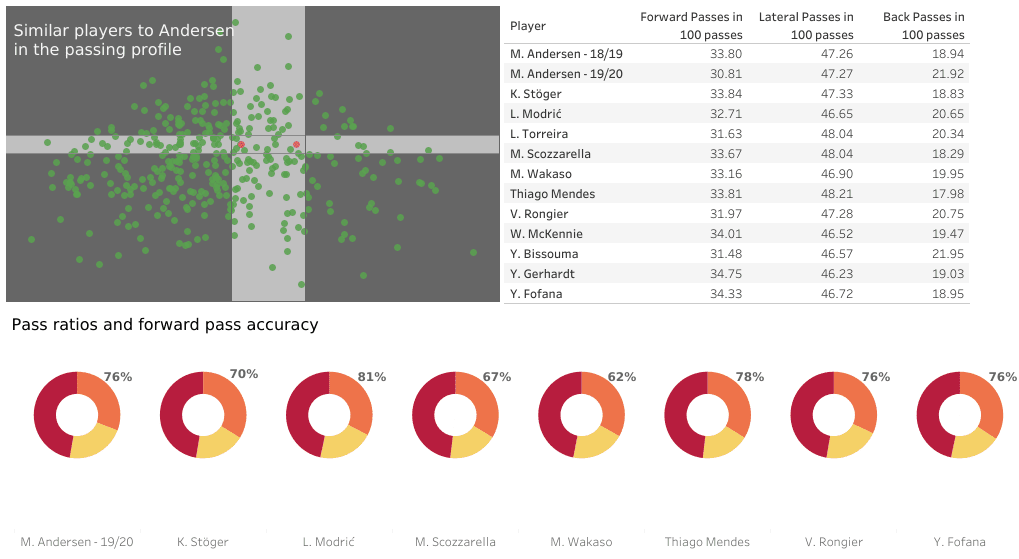
To tackle the problem of possession-based versus counter-attacking teams, we standardized the passes to 100 passes. This way we can get a clear image of potential prospects. Moreover, including both seasons from Andersen broadens the spectrum and gives us a range to search in. As you can see, the dots coming from the common grey area return players with similar values. After filtering based on physical attributes (height and weight), we can identify the seven midfielders that are alike to Andersen.
Floor and ceiling
After dropping Mubarak Wakaso and Matteo Scozzarella due to low forward pass accuracy, we are left with five players. In this section of the analysis, the quality will be the key factor to determine a minimum and maximum player potential that Andersen could reach in his career.
Recoveries
Andersen’s versatility comes from the ability to cover large areas in defence. He won’t push too far ahead but he gives stability to the team. The largest amount of his recoveries happen in the central third of the pitch while he equally contributes in the final third and closer to his goal. Compared to him, Valentin Rongier is more active in the opposition third but they are similar in their overall defending. It is also possible to say that Andersen could help out teams defensively while we will see that his passing still remains elite.
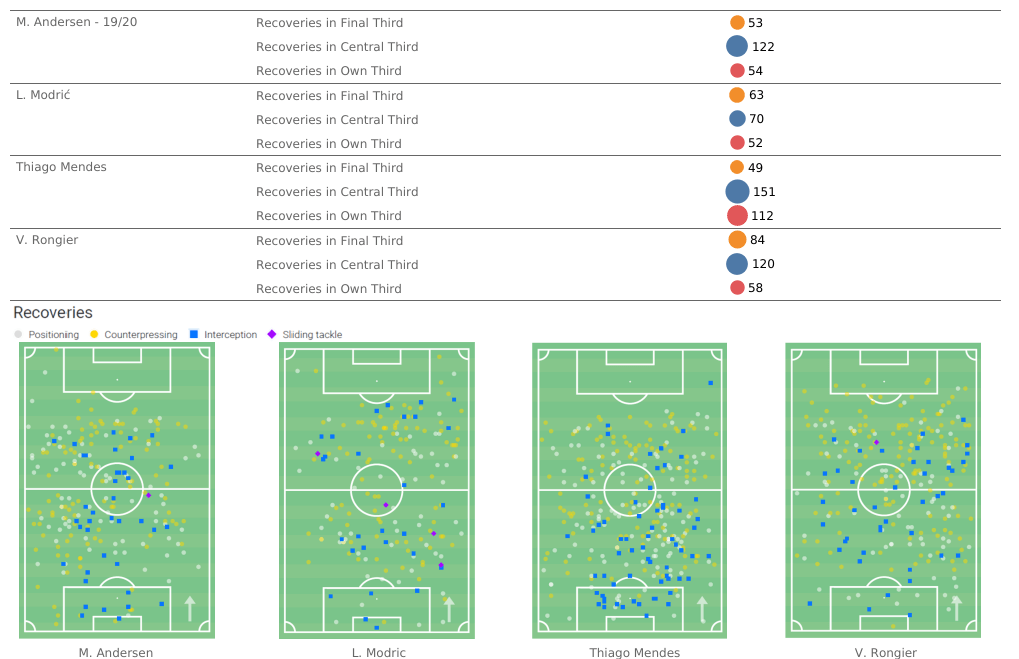
Progression
Andersen can carry the ball in numbers usually on the left side of the pitch. It is not a stretch to compare him to Real Madrid-star, Luka Modric or Lyon’s Brazilian midfielder, Thiago Mendes. At the age of 21, Andersen can occupy the central part of the field with great passing range and brave runs into the final third.
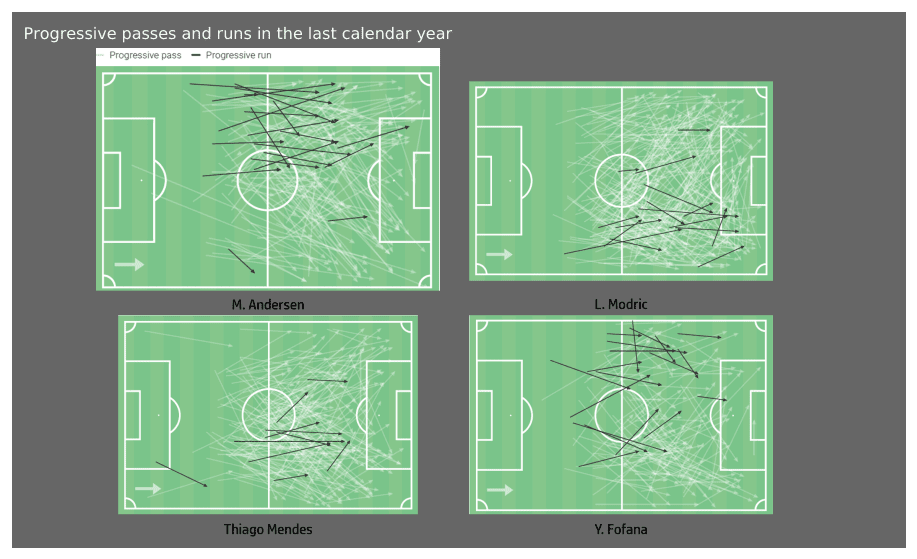
Penalty area deliveries
All four maps show the tendency of these players sending balls to the half-spaces within the penalty area. Thiago Mendes appears to be a match to Andersen but it is worth to notice that only Modric gave more passes that find teammates inside the box (40) than the Nordsjaelland captain (28).
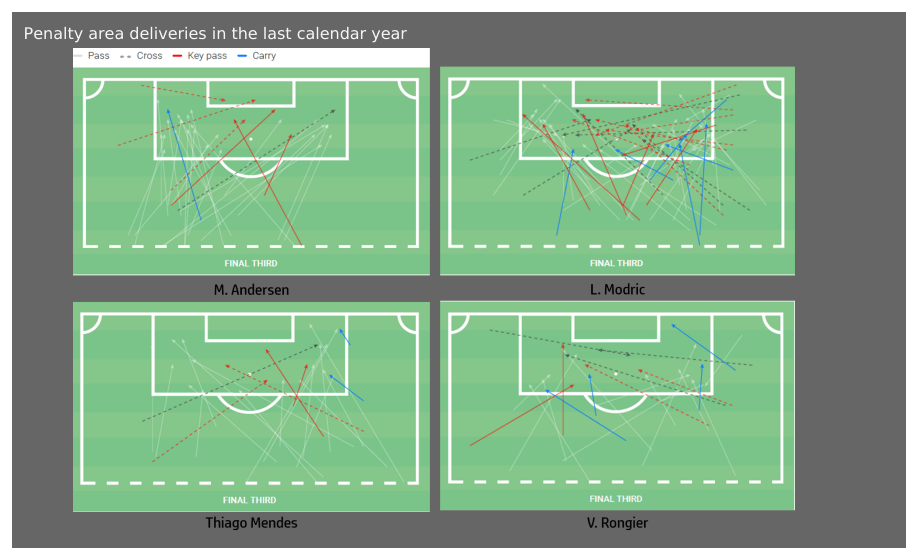
All in all, Andersen could become a great all-round player in the future. He has the defensive upside of Rongier and the delivery skills of Modric and Mendes. If we take a look at them, all three worth currently over 12 million euros, with obviously Modric being 34, his value is measured with his game more than his potential transfer fee. However, Rongier and Mendes, 25 and 28-years old, could be cornerstones when we analyse Andersen’s potential.
The next step
Andersen has two years remaining from his contract while his current value stands at 2.3 million euros. He could be a wanted man soon in Europe as he is likely to improve in the future. With him, the team will continue to amaze us with great young talents and the more experience, the more success will await Nordsjaelland.
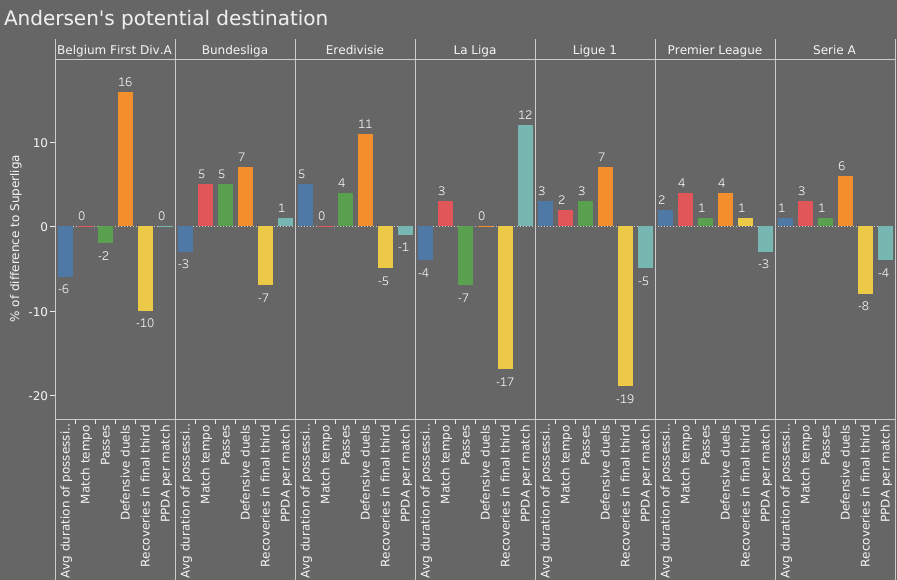
If we analyse the characteristics of the Danish Superliga, we can find the most similar leagues where adaptation could be easier to Andersen. Based on the league differences, three options emerge in front of us. The Premier League might be a big jump for him right now but it is indisputable that the two leagues show identical characteristics. Serie A could be another destination picked by a couple of Danish players nowadays with success. Bologna recently signed Andersen’s former teammate Andreas Skov Olsen and Sampdoria also prefer the Scandinavian market.
The final choice could be Ligue 1. It is no accident that Rongier or Mendes appeared among the midfielders with similar traits. Andersen could have the time to improve in France and if paired with a strong defensive midfielder, he could thrive in the league.
Conclusion
Magnus Kofod Andersen is not an average player. He is a brave midfielder with great passing range and vision. His statistics come from the nature of his game, which means that he will always try to progress the ball and won’t care about short options closer to him. His quality and similarities might prove the numbers wrong in the long run and there is a chance he could become the next generational leader of Denmark. In this data analysis, we aimed to build up his profile based on various metrics and ratios to get a clear picture of him.
He is a deep-lying playmaker who improved in going forward. His previous two seasons as the captain of Nordsjaelland brought above-average numbers among the midfielders of the top five leagues but there is still room to improve in passing. Within his age group across Europe, he is not outstanding in any charts but he can still create a buzz in the market later. If he stays on track and continues to improve, we can expect him to hit similar heights as Rongier. It would be risky to suggest that ‘he could become the next Modric’, although there are certain elements in his game that remind us of the Croatian genius.
Finally, finding the next step and moving from Denmark will be tough but it is a necessary move that he will require to move forward in his career. Based on the percentage differences in the top leagues to the Superliga, we suggest that a move to France or to Italy would be the most beneficial for Andersen. Whatever happens in the future, it will be very much worth to keep an eye out on him.





Comments